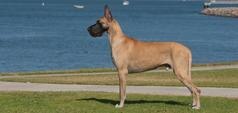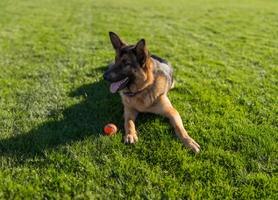
Bloat in German Shepherds: The Influence of Genetics and Environment

Longtime co-breeders and co-owners of German Shepherd Dogs, Bo Vujovich (Rosewood) of Cannon Falls, Minnesota, and Diane Mehra (Blackwood) of Canon City, Colorado, have never forgotten their first dogs that developed gastric dilatation-volvulus (GDV), or bloat.
Vujovich had never previously experienced the disorder in a dog in 1999 when her 4-year-old male, “Donny” (CH Rosewood’s Adonis Of Anne-Isle TC), bloated. “Donny was a magnificent example of the breed,” she says. “He had outstanding temperament and extraordinary movement. One night he became quite agitated, and I attributed it to a bitch in season. By the next morning, his condition was too far gone to save him.”
On Labor Day weekend in 2014, Mehra recalls glancing at her 5-year-old female, “Frannie” (De Paul’s Francesca v Blackwood) to see her abdomen distended on both sides. “She looked like a goat,” she says.
“Frannie was beautiful and athletic,” Mehra says. “She also was sweet, intelligent, happy, and well-adjusted. Emergency surgery saved her life. I had a gastropexy done right then to ensure she would not have a repeat GDV episode. Frannie lived a healthy life, recently dying at age 12.”
German Shepherd Dogs are among nearly 50 large and giant breeds susceptible to GDV. The third most popular breed in the country based on 2020 registrations with the American Kennel Club, the German Shepherd Dog may be the No. 1 breed for bloat due to the sheer number of cases.
“It is really difficult to predict which dogs will bloat,” Vujovich says. “If you breed many dogs and are around long enough, it’s going to happen.”
Mehra agrees. “Bloat is so common in our breed. It’s very sad,” she says.
Traditionally, it has been thought that GDV occurs when the stomach fills like a balloon with gas, a process known as gastric dilatation. As bloat progresses, the gas-filled stomach twists 180 degrees clockwise on its side, cutting off an escape for the gas through the esophagus or duodenum. This is gastric dilatation-volvulus. A profound distension of the stomach compresses vital blood vessels and organs in the abdomen and reduces oxygen to those organs causing a life-threatening condition as tissue death and toxins are released into the bloodstream.
“Evidence today suggests that torsion, the flipping of the stomach, may come first when a dog bloats,” says Elizabeth A. Rozanski, DVM, DACVIM, DACVECC, associate professor at the Cummings School of Veterinary Medicine at Tufts University. “That twisting likely seals off the escape of gas produced by fermentation causing the stomach to swell. As the
gastric pressure increases, critical blood supplies to both the stomach and the whole circulation are cut off sending a dog into shock.”
No single cause is linked to bloat. “A combination of genetic and environmental factors contribute to bloat,” Dr. Rozanski says. “It’s important to realize that most dogs bloat because of their conformation, and the size of the dog is intrinsically linked to conformation. Deep-chested large and giant breeds are vulnerable to bloat.”
An emergency condition, bloat progresses so fast that dogs can die within two hours of the first clinical signs. As the gas builds in the stomach, a dog becomes increasingly uncomfortable. Owners may notice their dog pacing, panting, retching unsuccessfully, or standing stiffly with a hunched back. Clinical signs include a distended abdomen, pale gums, and a weak, rapid pulse. Shock may occur when the vena cava, the large vein carrying deoxygenated blood back into the heart becomes blocked from the stomach’s twisting and distension.
Emergency surgery to untwist the stomach and check for dead tissue provides the best outcome for dogs with GDV. Prior to surgery, a veterinarian must stabilize a dog by relieving the pressure from the gas in the stomach and treating a dog for shock with intravenous fluids. As with Frannie, gastropexy is always performed during emergency surgery to prevent GDV from recurring.
Gastropexy involves tacking the stomach to the right side of the abdominal wall to prevent future shifting or twisting of the stomach. A minimally invasive procedure, gastropexy is recommended to be done prophylactically at a young age, particularly in dogs having a parent, littermate or half-sibling that has bloated. At many clinics, a veterinarian performs a gastropexy laparoscopically using two to three incisions and cameras to help guide the procedure.
When dogs die before GDV surgery can be performed, it is primarily due to shock and cardiovascular instability. Dr. Rozanski and Claire R. Sharp, BVMS, MS, DACVECC, formerly of Tufts Cummings School of Veterinary Medicine and now at Murdoch University in Australia, looked at the systemic effects of GDV. Their review, published in 2014 in Topics in Companion Animal Medicine, signalled decreased oxygen to tissues caused by cardiovascular dysfunction as setting in motion a systemic state known as multiple organ dysfunction syndrome. Dysfunction can affect the cardiovascular, respiratory, gastrointestinal, coagulation, and renal systems.
Additionally, Dr. Rozanski says, “Other organ dysfunction can develop in the postoperative period that requires specific management and can contribute to late morbidity and mortality. Awareness of the potential for multiple organ dysfunction syndrome and aggressive supportive care are essential to maximize the chances for a successful outcome for dogs with GDV.”
Without gastropexy, GDV recurs in 80 percent of affected dogs compared to a recurrence of less than 5 percent in dogs with gastropexy. While prophylactic gastropexy may decrease the prevalence of GDV in susceptible breeds, it does not eliminate the risk for mesenteric volvulus. Mesenteric volvulus occurs when the small intestine twists around the mesentery root that provides nutrients to the intestines. Although rare, mesenteric volvulus is almost always fatal.
A study published in 2018 found an inverse relationship between decreased GDV cases due to prophylactic gastropexy surgery and increased incidence of mesenteric volvulus. The retrospective study looked at 54 mesenteric volvulus cases and 157 controls to determine potential risk factors for the disorder in military working dogs treated at the Holland Military Working Dog Hospital at Lackland Air Force Base in San Antonio. German Shepherd Dogs comprise 60 percent of the Department of Defense’s military working dogs.
Predisposing risk factors included breed type, specifically German Shepherd Dog, increasing age, and history of gastrointestinal disease, gastropexy or other abdominal surgeries. Because GDV had been a longstanding cause of death or reason for euthanasia of military working dogs, in 2001 the U.S. military began implementing a prophylactic gastropexy policy for all working dogs in their early adult years that was rolled out over several years.
Comparatively, there were 116 cases of GDV from 1990 to 2000 before the policy went into effect, 95 cases from 2001 to 2009, and 11 cases from 2010 to 2016. During the same timeframe, six incidents of mesenteric volvulus were reported from 1990 to 2000, 12 cases from 2001 to 2009, and 48 cases from 2010 to 2016.
The link between gastropexy and mesenteric volvulus is unclear, the authors stressed. Thus, the benefit of gastropexy in preventing GDV likely outweighs the risk of the rare condition mesenteric volvulus, they said.
A Genetic Basis for Bloat
Much is not known about what causes GDV. It is considered a complex, multifactorial disorder with genetic and environmental influences. German Shepherd Dog enthusiasts suspect that bloat may occur more frequently in some bloodlines.
As Mehra, who breeds German Shepherd Dogs under the Blackwood
prefix, says, “We call it the bloat-torsion pedigree.”
Efforts to better understand the
genetics of bloat prompted researchers at Tufts Cummings School of Veterinary Medicine to compare DNA samples from purebred dogs that had bloated with dogs of similar ages and breeds that had not experienced GDV. The study from 2014 to 2018 was funded by the AKC Canine Health Foundation with support from 35 sponsors, including the American German Shepherd Dog Charitable Foundation and the German Shepherd Dog Club of America.
An article on their findings about genetic susceptibility factors in large and giant breeds, which have a lifetime risk for bloat of 3.9 to 36.7 percent, was published in Genes in November 2020. The genome-wide association study (GWAS) of 253 dogs from 10 breeds included 147 dogs that had experienced at least one GDV episode and 106 healthy control dogs. Single nucleotide polymorphism (SNP) array genotyping followed by imputation of common genetic variation was performed on 241 samples to identify GDV-associated SNPs and copy number variations.
The 10 breeds represented were: Borzoi (25.6 percent), German Shepherd Dog (21.9 percent), Great Dane (13 percent), Standard Poodle (9.8 percent), Doberman Pinscher (6 percent), Briard (5.6 percent), Labrador Retriever (4.7 percent), Golden Retriever (4.7 percent), and German Shorthaired Pointer (4.7 percent).
Lead investigator Dr. Rozanski explains, “We then used whole-genome sequencing (WGS) on a subset of 18 GDV dogs and 15 healthy controls of the three highest represented breeds — Borzoi, German Shepherd Dog and Great Dane. We identified a potentially protective intergenic SNP, minor allele G, that appears across all breeds and that is particularly
important in Collies, German Shorthaired Pointers and Great Danes.”
Subsequent analysis identified 12 additional significant potentially protective SNPs as well as deleterious SNPs. Notable significant SNPs were found in these three genes involved in gastric tone and motility, VHL, NALCN and PRKCZ.
“These are potentially important clues to the risk factors of bloat,” Dr. Rozanski says. “Although further studies are needed to validate the SNPs identified in the study and their association with GDV susceptibility — as well as their potential breed associations — the genes in which they are located have notable roles in the enteric nervous system and GI motility.”
Survival Statistics & Focusing on Prevention
Just as GDV is a multifactorial disease in terms of its causes, whether a dog survives bloat is also multifactorial. Dr. Sharp and Dr. Rozanski along with colleagues looked at the hospital records of 498 dogs that bloated from September 2001 to April 2011 to understand why dogs die prior to surgery in an effort to account for preoperative nonsurvival. The dogs were patients at the Foster Hospital for Small Animals at Tufts Cummings School of Veterinary Medicine.
“Excluding the 179 dogs that died or were euthanized prior to surgery, 83.5 percent, or 318 dogs, survived to go home,” Dr. Rozanski says. “Overall, about 64 percent of the dogs studied survived. We found that financial reasons were a major risk factor in nonsurvival. Of the 179 non-surviving dogs, 149 were euthanized and 30 died. Of those euthanized, 116 were euthanized prior to surgery without the intent to treat.”
Although costs vary based on geographical area and individual clinic, emergency bloat surgery, including gastropexy, may range from $4,000 to $10,000. Prophylactic gastropexy performed on a nonemergency basis may cost from $1,200 to $2,000.
Given the rate of GDV nonsurvival due to nontreatment, efforts at disease prevention may be the best way to improve disease mortality. “If you have a bloodline with young dogs bloating and multiple littermates bloating, it is likely an indicator of risk genes,” Dr. Rozanski says. “You should try to gradually breed away from these dogs.”
Environmental triggers can contribute as well. “In some lines, stressors such as a stay at a boarding kennel can make them more likely to bloat, particularly in dogs that are anxious and nervous,” she says. “If you have an anxious German Shepherd Dog, it may be helpful to avoid stressful situations.”
Mehra and Vujovich, who each have 30 years’ experience breeding German Shepherd Dogs, educate puppy buyers about the signs of GDV and encourage them to have a prophylactic gastropexy performed early. “Most people cannot afford emotionally or mentally to lose an animal to GDV,” Vujovich says. “Gastropexy offers protection against this happening.”
Both breeders ponder the breed’s vulnerability to GDV. “The abdominal muscles seem to become lax over time giving the stomach more room to twist,” Vujovich says.
“Bloat was not a health concern in German Shepherd Dogs until the 1980s when breeders began producing dogs with a deeper-bodied conformation to achieve an extended side gait,” Mehra says.
Mehra, whose Frannie survived bloat, says, “She was the least likely dog to bloat because she did not have the body type prone to GDV. She had very tight ligamenture and abdominal muscles. She was happy, well-adjusted, and not a nervous or anxious dog.”
As to her breeding practices, Mehra says, “I choose breeding partners very carefully. I look for lines with longevity and those free of GDV for one or two generations. I also am cautious not to ‘throw the baby out with the bath water.’ Doing so could result in the loss of genetic diversity.”
“Bloat just happens,” Vujovich says. “You can have the best practices and routines for your dogs and still come up with one that bloats.”
Reflecting on the significance of the genetic work, Dr. Rozanski says, “We are years away from figuring this out, but our findings lean toward support of a role of genetics in dogs that bloat. Maybe all German Shepherd Dogs are somewhat genetically at risk.”
Purina® Pro Plan® is the #1 brand most fed and recommended brand by dog breeders in Canada.* Learn more about the what the Pro Club Breeder program has to offer, including up to 25% savings on Pro Plan dog and puppy food, a free bag of puppy food for your new pet owners and more!
*Canadian Dog Fancier survey results, November 2023
Related articles


